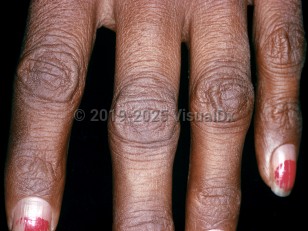Addison disease in Child
See also in: Oral Mucosal LesionAlerts and Notices
Important News & Links
Synopsis

Adrenal gland dysfunction can be a result of adrenal dysgenesis, destruction, or impaired steroid hormone synthesis. These categories each contain multiple possible etiologies including congenital disorders, autoimmune diseases, metabolic syndromes, infections (ie, tuberculosis, fungal, cytomegalovirus [CMV], HIV), malignancies, vascular infarction / hemorrhage, and medications (eg, etomidate, azoles, suramin).
The most common cause of Addison disease in pediatric patients is congenital adrenal hyperplasia (all subtypes), which accounts for approximately 70% of all cases and has an incidence of 1 in 15 000 live births. Other causes include autoimmune adrenalitis, autoimmune polyglandular syndromes (types 1 and 2), congenital adrenal hypoplasia, X-linked adrenoleukodystrophy, congenital unresponsiveness to adrenocorticotropic hormone (ACTH), and peroxisomal cholesterol biosynthesis disorders.
Addison disease from adrenal hypoplasia or congenital adrenal hyperplasia presents in early infancy. After infancy, autoimmune damage to the adrenal gland is the most common cause. The autoimmune destruction may be idiopathic (patients typically have a personal or familial history of autoimmune disease), where disease onset can be at any age, or result from autoimmune polyendocrine syndrome, where disease onset is in early childhood. Addison disease caused by reduced ACTH production (due to medications or a pituitary tumor) can present at any age. Other causes such as adrenal metastasis, drugs, infections, amyloidosis, and adrenal vascular infarction / hemorrhage are more likely with increasing age.
The adrenal insufficiency leads to an insufficient production of glucocorticoids, mineralocorticoids, and adrenal androgens. The symptoms associated with Addison disease are related to deficiencies of each hormone and usually develop over time from progressive destruction of the bilateral adrenals, but can onset more rapidly with congenital disorders or traumatic insults to the adrenals. The disease is characterized by general symptoms of fatigue, weight loss, weakness, vomiting, dizziness, cold intolerance, and muscle aches. Because these symptoms are nonspecific, the diagnosis may go unrecognized until the patient presents with a life-threatening adrenal crisis.
Over time, a significant fraction of patients with Addison disease will develop generalized skin and mucosal hyperpigmentation due to an increase in the production of pro-opiomelanocortin (POMC). POMC is a pro-peptide hormone that is cleaved to produce various products including ACTH, beta-endorphins, and melanocyte-stimulating hormone (MSH). In the absence of adrenal hormone negative feedback to produce more ACTH, POMC secretion is elevated. The byproduct, MSH, stimulates melanin production, resulting in skin hyperpigmentation. These and the other clinical signs of the disease typically appear only after 90% of the adrenal gland is nonfunctioning.
Addisonian crisis:
Acute adrenal failure presents with severe abdominal pain accompanied by vomiting and diarrhea, low blood pressure, and loss of consciousness. This is a state of distributive shock and is a potentially life-threatening emergency that must be managed aggressively.
Codes
E27.1 – Primary adrenocortical insufficiency
SNOMEDCT:
363732003 – Addison disease
Look For
Subscription Required
Diagnostic Pearls
Subscription Required
Differential Diagnosis & Pitfalls

Subscription Required
Best Tests
Subscription Required
Management Pearls
Subscription Required
Therapy
Subscription Required
Drug Reaction Data
Subscription Required
References
Subscription Required
Last Updated:04/01/2024

